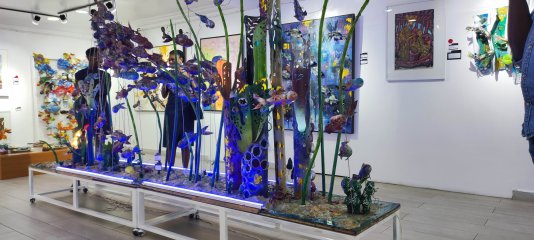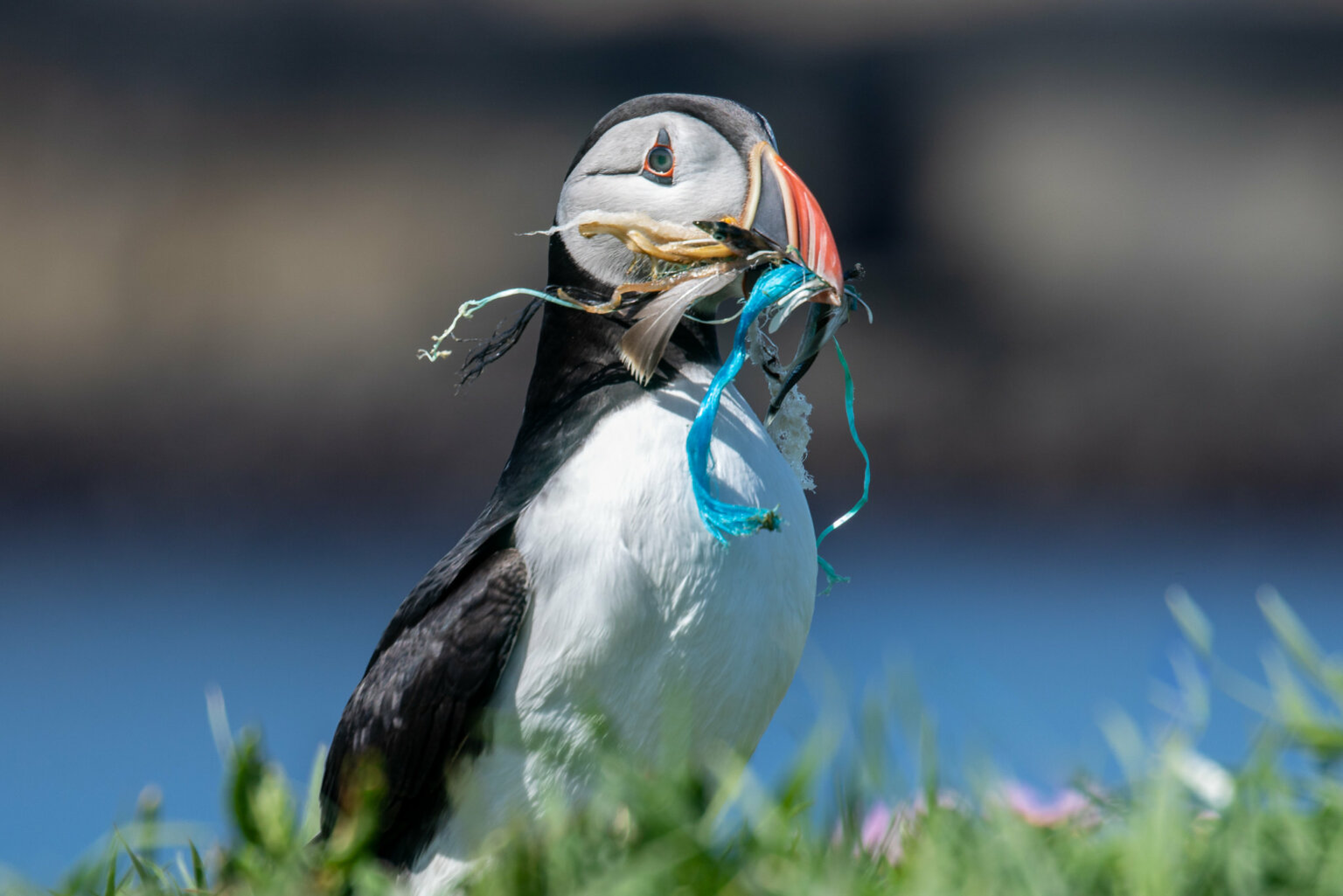- About
- Topics
- Picks
- Audio
- Story
- In-Depth
- Opinion
- News
- Donate
-
Signup for our newsletterOur Editors' Best Picks.Send
Read, Debate: Engage.
| November 29, 2022 | |
|---|---|
| topic: | Arts |
| tags: | #Nigeria, #recycling, #upcycling, #art, #plastic |
| located: | Nigeria |
| by: | Ekpali Saint |
About 100 million tonnes of plastic waste are generated globally each year. 90 percent of discarded plastic isn't recycled and ends up in landfills, drainages or oceans, which, in addition to polluting the environment, exacerbates the climate emergency through the release of methane and ethylene.
According to the World Bank, Nigeria is the biggest generator of plastic waste in Africa, and has the fastest growing e-waste problem in Sub-Saharan Africa.
Over 88 percent of about 2.5 million tonnes of plastic waste generated in Nigeria annually is not recycled, and the crisis only appears to be worsening due to the country's growing population rate, low waste management capacity and lean investment in recycling and upcycling.
Gbenga Adeku, an upcycle artist from south-western Nigeria, is helping protect his local environment through art and uses his works to promote climate action and awareness.
Adeku obtains PET bottles and beverage cans from women in the community and converts them into art pieces for educational and awareness-building purposes.
The idea for the project came after after he observed PET bottles blocking water ways in his community, which resulted in a flood.
FairPlanet spoke to Adeku about the inspiration behind his work, his creative process and the impact his art has on his surroundings.
This interview has been edited for clarity and concision.
FairPlanet: Tell us a bit about your journey as an artist.
Gbenga Adeku: I was born an artist, and rumour has it that I was holding a brush in my mother’s womb. But that's just a rumour. The fact is that sometime in the early 90s, I was born to the family of Segun Adeku, a neo-traditional Osun Osogbo artist.
I took formal training in applied art at the Great Ife Art School of Obafemi Awolowo University [in Nigeria’s southwestern Osun State], specialising in painting and minoring in graphic art from 2010 to 2015.
In 2019, I founded Xtetixupcycle, an upcycle art company aimed at building knowledge capacity to meet climate change through art as a visual educational tool, training, material exploration and research in upcycling.
I currently live and run an upcycle art studio in Ile-Ife, Osun state.
What inspired you to use art to promote climate action and awareness?
Growing up, my dad got National Geographic magazines [as a gift] from his close elderly friend. The photography and little animal stories caught my eye. Dad would sometimes give us his binoculars to view birds patching around. That interest was there, but was not active until I read an article showing how plastic pollution kills and poisons wildlife, especially marine ecosystems. Then it clicked.
I was as guilty as everyone else, since PET bottles disappears from my consciousness as soon as the beverage finishes.
[My] experiments with and research about upcycling several solid waste materials started back in 2015. I had a place where I stored [...] all sort of solid wastes, including plastics and bottles.In 2019, I started creating arts from the plastic bottles I collected.
What is the significance of these materials (PET bottles and beverage cans) to your mission of tackling climate change and protecting the environment?
The goal is not to clean the world, the goal is to clean the mind of the person who sees this artwork as [it] subconsciously forces a rethink about plastic.
The art turned the [plastic] material into treasure, and so other creative minds in other fields will see it. That rethink ripples its effect back to the environment through newly cultivated sustainability habits and behaviors.
The newly cultivated habit is recycling at the barest minimum. Other ones would be a reuse mentality; maybe they find other things they could change plastic into.
What are your thoughts and observations about the plastic pollution situation in Nigeria, given that the majority of plastic waste generated here is neither recycled nor upcycled?
Nigerians like me like to think that our environment is secured because of the greenery surrounding us. It is an unfortunate delusion.
Plastic pollution is huge here. Environmental NGOs such as Lagos Coastal Plastic Search and a host of others are actually the ones doing the bigger work, as they build communities and engage them through mutual reward systems.
This doesn't match the speed and volume of plastic waste being generated daily, as public education is still the first and most important task towards a plastic free Nigeria. That education must go beyond cities and communities.
How exactly does your work promote climate action and awareness?
My art exhibitions are where direct climate education takes places through storytelling surrounding each art piece. There is a process to this and it takes several months, as they all have to happen in batches based on the installation nature of my work.
[The process involves]: [blowing, bending, cutting and engraving through] the use of pressure and heat; joining two or more plastic and aluminum bodies to create a figure; using a paint machine to colour the figure with industrial paint; painting with brush patterns and skin details; adding neon paint, gold foil and buttons; and creating a painting, a net or a stand to which the figures are to be attached.At exhibition, each work has content around it. When people come in, we take them around and explain the climate [significance] to them. So people understand climate change especially as it relates to plastic. We also teach them how to keep plastics.
So much of the climate education and awareness is done during the exhibition. [But] creating engaging content through videos and social media post [also] helps me share the tiny bits of the process with others.
Can you tell us about the significance of the subjects of your artwork - ants and fish?
Ant colonies are powered by waste. Most often, they clean the environment, clear off dead cockroaches and other things they find.
They have a rich economy built on waste - not on generating waste, as humans do. I use them to represent life on land. Our human lives on land could do better if we learn from ants.
The ants also symbolise team work, to show no one achieves something without the help of another; meaning fighting climate change is the business of everyone. Everyone should be involved.
My fish represents life below water. Marine life, which is the most affected by plastic waste, is actually the bigger beautiful part of this planet. The water body is a living art and still grossly unexplored. The greater hazard is when the PET bottles go into the ocean and then break down into becoming poison to fishes. They are poisons to land, too, but it takes 400 years while ocean is 200 years.
I use these aquatic artworks as an irony of what plastic destroys. The goal is to get people to love plastic and the ocean, to value both by separating them from each other.
You recently organised an art exhibition titled Orilafinju. Can you tell us a bit about the exhibition and how it helped spread your message?
Orilafinju means 'the mind is the environmentalist.' 13 high-end upcycle artworks were displayed with 13 titles, and over 13 pro-environmental stories were told with each piece. Over 5,000 individuals physically experienced these works at Terrakulture gallery between 5 May and 4 July 2022; this included group visits such as schools, NGOs & social clubs.
Over 100 million people heard about the art show through social media posts and ads, two newspapers interviews and three television appearances.
Would you say there is enough awareness on climate change in Nigeria? And how are you using your artwork to fill the gap?
There's definitely awareness. It's just that people take action emotionally, not logically. So, an awareness that is not emotionally attached to the communities may never spike an environmental revolution. Hence my work brings that attachment.
In terms of waste management capacity and investment in recycling and upcycling, what are your thoughts on the government’s efforts given the growing population rate in the country?
The government can only try in their capacity, [and] more can be done to encourage and create better structures for environmental businesses.
Recycling centers and pickup point would do well if they become as flexible and profitable as Point of Sale (POS). Usually, banking is something you have to go to the bank for any transaction. These days, people now use mobile apps. To avoid traffic from a lot of people who queue in the bank, POS was made available for individuals. So the same thing can go for environmental things.
POS is everywhere not because people have passion for it, but because it is profitable. So if places [pop up] where we can drop our waste, maybe when you drop a bag you get a mug, or when you drop a bag of plastics you get a shirt. This will go a long way in reducing plastic waste. It has to have more value.
Can you name some of the challenges you face as you try to raise environmental awareness through your work?
Luxury Art in galleries still speaks majorly to the elite. Waste is generated by everyone, that is why we are currently working on structures to get upcycling to grassroots through training and exhibitions in schools, and then, one day, charity art exhibitions for raising donations to environmental NGOs in local communities.
Also, moving the works around is a challenge. Many come in from different countries for these exhibitions, but can’t take the experience to their countries. That’s [another] limitation we currently have that we can’t take the experience to other places. For us to cover that limitation, we are trying to leverage on "partial reality." We want to recreate some of these works in virtual reality and then host that experience on metaverse so we can have more people. So a link takes you to a virtual gallery where you can see them.
The only difference is that you may not have opportunity to touch the art - but you would have gotten really close to the experience.
Any last advice you'd like to give to our readers?
Plastic poisoning is becoming a pandemic, but I hope not, since humans' super-strength is the ability to change. So the practical step is to "keep that bottle till you find something to do with it."
To my fellow upcycling artists I would say: let's do more. The world needs us now than ever.
Image by Gbenga Adeku.
By copying the embed code below, you agree to adhere to our republishing guidelines.



